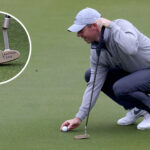Mastering the game of golf begins with the basics, and one of the most fundamental skills to learn is how to properly hold a golf club. Your grip is your only connection to the club, and it significantly influences the accuracy, power, and control of your shots. Whether you’re a complete novice or looking to refine your technique, here’s a step-by-step guide on how to correctly grip a golf club.
Choose the Right Grip for You
There are three main types of golf grips: the overlapping, interlocking, and baseball grips. Each type has its advantages and is suited to different skill levels and hand sizes.
Overlapping Grip (Vardon Grip): This is the most common grip among professional golfers. Place your dominant hand (the right hand for right-handed players) below your other hand, with the pinkie finger of the dominant hand resting in the gap between the index and middle finger of the other hand.
Interlocking Grip: Similar to the overlapping grip, but here, you interlock the pinkie finger of your dominant hand with the index finger of the other hand. This grip is good for players with smaller hands or those who need a firmer grip connection.
Baseball Grip (Ten Finger Grip): This grip involves placing all ten fingers directly on the club handle, much like holding a baseball bat. It’s an excellent choice for beginners, younger players, and those with less hand strength.
Grip the Club at the Right Place
Your hands should be positioned on the end of the club. A common mistake is gripping the club too high or too low, which can distort the swing path and impact the shot’s direction and power. Ensure a few inches of the club handle are visible above your lead hand (left hand for right-handed golfers).
Hold the Club with Correct Pressure
Grip pressure is critical. Your grip should be firm yet relaxed. Over-gripping can cause tension in your arms and shoulders, leading to poor swing mechanics. A good rule of thumb is to hold the club with enough pressure to keep it from slipping during the swing but not so tight that it causes tension.
Align Your Hands
For an effective grip, your hands need to work as a unit. Make sure the back of your lead hand (showing your hand logo or glove logo, if you wear one) faces the target and the palm of your trailing hand faces the target as well. Both thumbs should point down the club shaft.
Check Your Grip Before Each Shot
Consistency is key in golf. Before each shot, take a moment to check your grip. This will help you maintain consistency throughout the round and improve your muscle memory over time.
Practice Regularly
Like any part of golf, mastering your grip takes practice. Spend time at the driving range working on your grip, and be mindful of how small adjustments affect the flight of the ball.
Your grip is the foundation of all your golf shots. While it might seem like a minor detail, a correct and consistent grip can immensely improve your game. Experiment with different grips to find the one that feels most natural and effective for your swing. With practice, a good grip will lead to better shots and lower scores.
Use Visual Aids to Enhance Learning
Many beginners find it helpful to use visual aids when learning how to grip a golf club. Instructional videos, diagrams, and even grip trainers can provide visual and tactile feedback that reinforces proper grip techniques. Consider using grip stickers or markers on your club to remind you of where your fingers should be placed.
Seek Professional Advice
If you’re struggling to find the right grip, consider taking lessons from a professional golf instructor. A qualified teacher can provide personalized feedback and adjustments that can make a significant difference in your performance. They can also help you understand more complex aspects of your grip, such as the grip’s impact on ball flight and shot shape.
Adjust Your Grip for Different Clubs
The way you grip the club may vary slightly between different types of clubs. For instance, you might find that a stronger grip (where you see more knuckles of your lead hand) helps you with your driver but not with your irons. Experimenting with slight adjustments can help you optimize your grip for each club in your bag, enhancing your overall game.
Pay Attention to Weather Conditions
Your grip can be affected by weather conditions, particularly if it’s wet or humid. In these conditions, it’s even more crucial to ensure that your grip is secure without being overly tight. Consider using golf gloves and grips with moisture-wicking capabilities to maintain an effective grip in any weather.
Understand the Psychology Behind a Good Grip
The confidence a good grip brings cannot be overstated. Knowing that you are holding the club correctly can relieve mental pressure and allow you to focus more on your swing path and shot planning. Cultivate a routine that includes checking and adjusting your grip as needed, which can help reduce anxiety on the tee box or fairway.
Monitor Your Progress and Make Adjustments
As you develop your golf skills, your grip might need to evolve. Regularly assess your grip’s effectiveness by noting your shot outcomes and comfort level. Don’t be afraid to make adjustments as your strength, flexibility, and skill level improve. What worked at one stage of your golf journey might need refinement as you advance.
Mastering how to hold a golf club is an essential skill that sets the stage for successful golf shots. It affects every aspect of your game and requires attention and practice. By following these guidelines, experimenting, and seeking feedback, you can develop a grip that feels natural and improves your performance on the golf course. Remember, even small adjustments can have a big impact on your overall game. Keep practicing, stay patient, and enjoy the journey of improving your golf skills!







